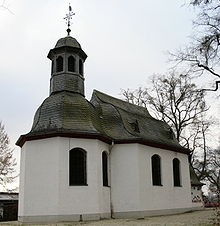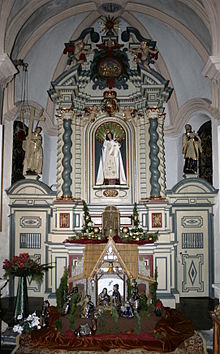Herzenberg chapel
The Herzenberg Chapel is a Marian pilgrimage chapel on the Herzenberg in the small town of Hadamar in Hesse . It represents an important place of pilgrimage in the popular piety of the region.
description
location
The Herzenberg is part of a ridge north and east of the Hadamar old town. At the location of the chapel, it reaches a little more than 200 meters above sea level. In the 19th and 20th centuries, residential development moved right up to the edge of the chapel district.
Building
In older research, the current choir of the building is referred to as a remnant of the first chapel, which was built in 1675, an octagonal central building only around 4.50 meters in diameter with a roof structure made of a hood and lantern . Accordingly, the structure was extended in 1691 by a longitudinal nave with rib vaults, to cover the canopy roof was also extended in an elongated shape. In recent research, however, the thesis is also advocated that the choir and nave were created together. A small vestibule was added later, which was renewed in 1860 and given a curved roof so that the chapel got its current shape.
Interior
The interior is dominated by a baroque high altar from 1693, which contains a medieval wooden figure of Our Lady with baby Jesus as the central worship image of this place of pilgrimage. The altar is flanked by statues of saints depicting Bernard of Clairvaux (on the right of Our Lady) and Francis of Assisi (on her left). They refer to Prince Regent Franz Bernhard , who was the decisive sponsor for the construction of the chapel.
Investigations from 2015 showed that the original interior of the chapel was unusually small for a baroque building. Possibly this should bring out the natural play of light through the windows and thus strengthen the relationship between the interior and the exterior. Four epitaphs from 1736 in the wall next to the altar close the burial places of the hearts of four members of Nassau princely houses. They consist of the regional black Schupbacher Lahn marble . It is one of the northernmost examples of a heart burial in Europe .
Church pews for around 50 worshipers, whose bench cheeks were carved at the time of construction or shortly after, complete the complex. On the walls of the canopy building there are numerous votive and thank you boards, most of which date from the time of the Second World War, but are still occasionally supplemented today. The current bell dates from 1807.
A stone plaque with the Nassau-Hadamar coat of arms is located above the entrance to the chapel. Similar to the statues of the patron saint on the main altar, this can be read as a reference to the special connection between Franz Bernhard and the chapel: The family coat of arms would have been common for a family foundation, but Franz Bernhard carried the princely coat of arms in his function as regent.
Outdoor area
A depiction of the crucifixion in a shrine around 30 meters across from the chapel exit and a fountain from 1986 complete the pilgrimage district. The surrounding light linden grove on the Herzenberg plateau also shapes the overall effect. This type of arrangement can be understood as an expression of the worship of God in his creation and through the view of his creation, which was particularly popular in the baroque era .
Immediately adjacent to the chapel is a publicly accessible show garden with a large number of different beds with around 2000 rose bushes and other plants. The rose garden was laid out from 1996 to 2013 and today covers around 3600 square meters. A steep way of the cross leads from the city to the Herzenberg, which was first laid out in 1697 and redesigned in 1908. At that time he received seven neo-baroque wayside shrines made of sandstone masonry and with terracotta reliefs. The “new way of the cross” from the 1950s leads over a different route to the Herzenberg. Around this time, the new cemetery, which adjoins the pilgrimage district to the east, was also laid out.
An ornamental garden was set up in the early 1980s on the former site of a former elevated tank for the city's drinking water supply. In the garden area next to the confluence of the old way of the cross in the chapel area there is now a pavilion, which is managed as a restaurant on Sundays in the summer.
Restoration history
The first more precisely comprehensible revision of the interior of the chapel took place at the end of the 19th century. At that time, the originally barely painted chapel was decorated with large, colorful wall paintings. The uncolored, clear windows from the construction period were replaced by neo-Gothic stained glass windows. Possibly the chapel should be brought closer to the then popular Mariengrotten in this way .
As early as 1950 this color version was replaced by a lighter wall design with individual painted columns and murals, but the windows were left. The color of the high altar was also restored around this time.
In 2013 the roof covering was completely renewed and the roof structure was partially renewed. Another restoration phase began in 2015, which deals with the interior of the building and is expected to last until 2017. In autumn 2016, the most important change in this building campaign was the stained glass windows that had already been replaced by clear windows and the walls were largely painted white without the paintings from the 1950s. A plaque in the lower area of the high altar has been removed to protect it from damage. The baroque parts of the stalls received a refurbishment and the benches were regrouped in such a way that they less obscure the princely epitaphs.
- Crossroads to the Herzenberg
history
The Herzenberg was originally known under the name "Hirtzberg" or "Hirschberg". This is possibly due to a game reserve of the count and later ducal house of Nassau-Hadamar. After the place became the heart burial place of the Hadamar princes, the current name became common.
Before the chapel was built, the students of the Jesuit college, founded in 1652, used the Hirschberg as a playground. In 1675 the Jesuits were given a site on the Hirschberg by the mayors, the aldermen and the city council. Father Johannes Musset distinguished himself as a particular sponsor of the chapel building. In the following years, some Jesuit students were used for the construction work. The Jesuits hold collections of money and building materials to make construction possible. After 1675 the first chapel, probably a wayside shrine , was completed.
In 1676 the statue of Mary was transferred from a Jesuit settlement in Koblenz. The Jesuits had acquired the sculpture from the Cistercian women in Koblenz. It may be the statue that disappeared from the Church of Our Lady , the former Hadamar parish church, during the Reformation . The first altar of the Herzenberg Chapel was donated by Anna Ludovica, the third wife of Prince Moritz Heinrich von Nassau-Hadamar. Apparently, a lively pilgrimage began quickly, because in 1690 Regent Franz Bernhard , himself a former student of the Hadamar Jesuits, had the chapel expanded and the current high altar made, as there was no longer enough space in the chapel for the users. In terms of church politics, there is a close relationship to the two other chapel foundations of the Princely House of Nassau-Hadamar in the immediate vicinity of the residence. The Franciscans received the cross chapel in Niederzeuzheim and the general public received the chapel of the 14 helpers in Steinbach .
The hearts of Franz Bernhard von Nassau-Hadamar, † 1695, Franz Alexander von Nassau-Hadamar, † 1711, Franz Hugo von Nassau-Siegen, † 1736 and Wilhelm Hyacinth von Nassau-Siegen, † 1743, are buried in the chapel .
Until the 20th century, the Herzenberg Chapel was the destination of several annual inner-city processions and regional pilgrimages. This pilgrimage has now largely ceased.
Numerous legends surround the pilgrimage site. Reports of luminous phenomena over the construction site have come down to us from the night before the foundation stone was laid. In addition, numerous surprising answers to prayer are reported.
Todays use
In addition to several smaller church services, the Feast of the Assumption of the Virgin Mary with the attached Herzbergfest attracts a large number of visitors. Officially, the pilgrimage on the Herzenberg lasts from May 1st to the end of September each year. The association "Friends of the Heart Mountain" supports the parish today in maintaining the chapel and its surroundings.
literature
Web links
- State Office for the Preservation of Monuments Hesse (Hrsg.): Herzenbergkapelle In: DenkXweb, online edition of cultural monuments in Hesse
Coordinates: 50 ° 27 ′ 6.6 " N , 8 ° 2 ′ 57.3" E




















